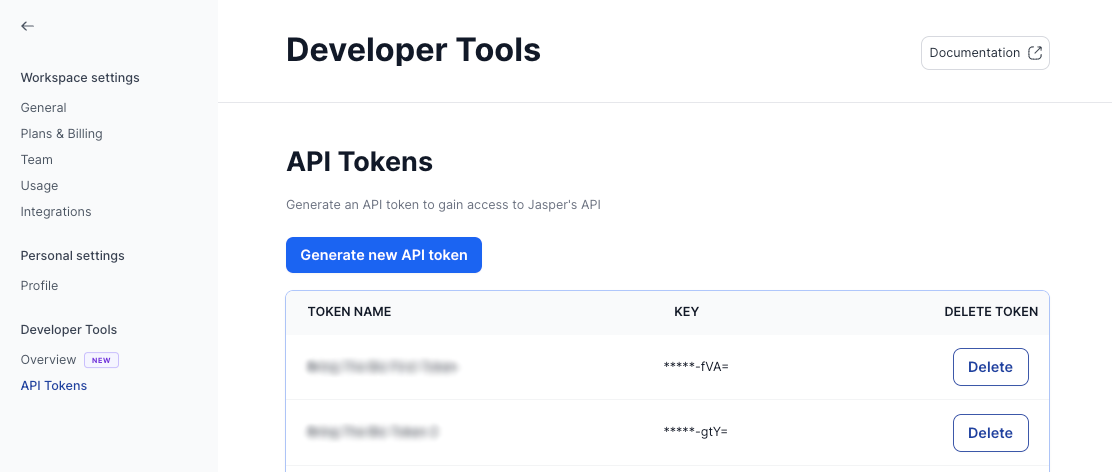入门
ℹ️在你开始之前
目前仅 Jasper 商业计划的客户可以访问 Jasper 的 API。 如果您想注册商业计划,请转到此处并请求演示以联系 Jasper: https: //www.jasper.ai/api 如果您是现有的商业计划客户,请联系您的客户成功经理讨论获取 API 访问权限。
第 1 步:生成 API 密钥

第 2 步:运行第一个命令
/commands``command``context``command``contextcontext1.
2.
X-API-KEY3.
{
"requestId": "4cfeeb0c-7dd3-4118-876a-f1da9acd2545",
"resource": "content",
"data": [
{
"id": "txt_54bdfbd7a0064953ae42f1f6f68069de",
"text": "Discover the perfect 8-string electric guitar for heavy metal and hard rock! The Primal Reverberations Medusa M-1 is a headless semi-hollow with a swamp ash body, Pale Moon 4A top, ebony neck and fingerboard, and two humbucking pickups. Enjoy it's high-performance Kaiju tuners, unbleached bone nut, 5-way pickup selector plus push/pull capacitance selection for alternate pick up mix variations. Unleash your inner beast today!"
}
]
}第 3 步:运行您的第一个模板
/templates1.
2.
X-API-KEY3.
{
"requestId": "324bd84a-c99c-413b-a0ad-15f46b33df60",
"resource": "content",
"data": [
{
"id": "txt_4c7f1d3f7ba84ce6ae54471a48fef6b7",
"text": "Blog Title: Why Conducting Incident Retrospectives is Critical for Software Development Teams\n\nBlog Introduction:\n\nSoftware development teams are responsible for designing, building, and maintaining software systems that support businesses' daily operations. However, with the complexity of modern-day software systems comes increased potential for incidents such as system crashes, data breaches, and other errors to occur. That's why it's crucial for software development teams to conduct incident retrospectives to identify the root cause of these issues and implement solutions that can prevent them from happening again in the future.\n\nIn this blog post, we'll explore why conducting incident retrospectives is critical for software development teams and how they provide value to organizations. We'll also discuss best practices for conducting effective retrospectives that lead to actionable insights.\n\nBlog Body:\n\n1. Identify the Root Cause of Incidents - Incident retrospectives enable software development teams to dig deep into each issue and identify its root cause. This process involves analyzing all aspects of an incident, including code changes, configurations, infrastructure changes, human error, or any other factors that may have contributed to the problem. By understanding what led to an incident in the first place, development teams can make informed decisions on how to fix it and prevent similar incidents from occurring in the future.\n\n2. Improve Team Communication - Incident retrospectives also provide an opportunity for developers and other stakeholders involved in a project to come together and discuss what went wrong. This fosters a culture of openness and encourages team members to share their thoughts and ideas freely. As a result, team communication improves significantly as everyone has a better understanding of what's going on within a project.\n\n3. Learn From Mistakes - Another critical benefit of conducting incident retrospectives is that they help teams learn from their mistakes. Through reflection on past incidents, development teams can identify patterns in their work processes or areas where they need improvement. With this knowledge at hand, they can develop new procedures or tools aimed at preventing similar incidents from happening.\n\n4. Facilitate Continuous Improvement - Incident retrospectives also facilitate continuous improvement within software development teams. By identifying the root cause of an incident, teams can implement changes to their development processes that can help prevent future incidents. Additionally, by discussing what went wrong and how it was addressed, teams can learn from one another and improve their overall skillsets.\n\n5. Build Trust with Stakeholders - Finally, effective incident retrospectives can help build trust between software development teams and stakeholders. By demonstrating a commitment to transparency and accountability, teams can show that they are taking steps to ensure that incidents won't happen again in the future. This can lead to more significant investments in projects and increased support for new initiatives.\n\nConclusion:\n\nConducting incident retrospectives is critical for software development teams as it allows them to identify the root cause of issues, improve team communication, learn from mistakes, facilitate continuous improvement, and build trust with stakeholders. To make the most out of these retrospectives, it's essential to follow best practices such as gathering data before the retrospective meeting, creating a blame-free environment during discussions, prioritizing action items after each retrospective meeting, among others.\n\nBy conducting regular incident retrospectives and implementing solutions based on insights gained from these meetings, software development teams can ensure that their systems are always running smoothly while building trust with stakeholders within their organizations."
}
]
}下一步
修改于 2024-01-30 06:49:29